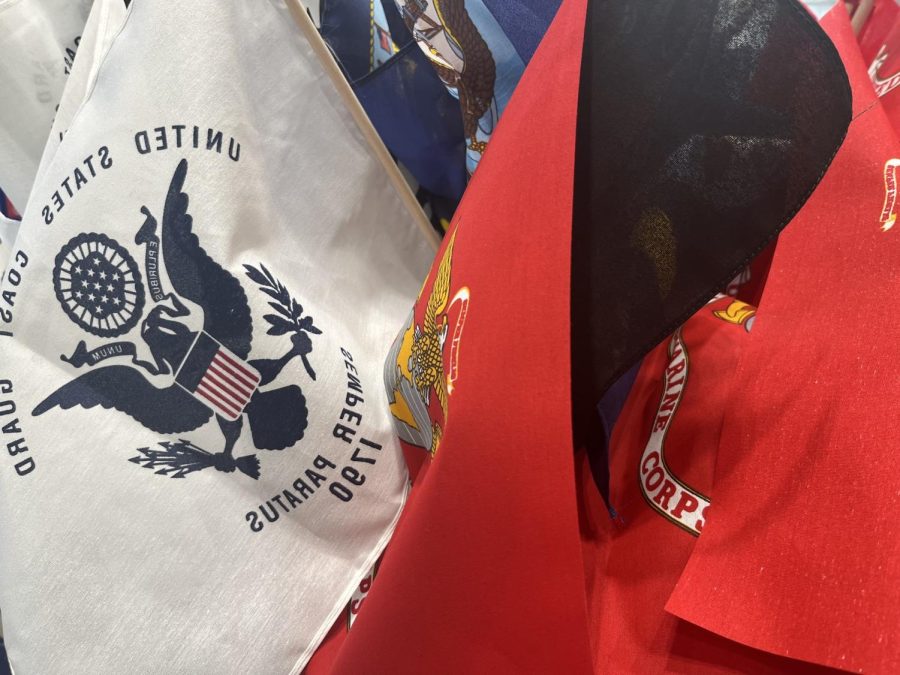Opinion: Hollywood’s Front Lines
The division between mass media’s perception of veterans and their material realities fundamentally neglects our actual at-risk veterans.
The military-entertainment complex allows the Department of Defense to have a tight leash on Hollywood’s movie production—especially surrounding movies they have a vested interest in.
May 29, 2023
They are our survivors. Our honor bound. Our zombie killers, our superheroes, our action figures. They also make up 13% of the homeless adult population. They have a higher rate of risk seeking behaviors, from sensation seeking to addiction to public aggression.
Veterans have an odd place in American social media, mass media, and propaganda alike. Almost every American agrees that they should be held in high regard, but there is a lack of depth in understanding their experiences, even in news media.
A researched relationship with American veterans is a fundamentally complicated one. It is often the most vulnerable young Americans that are targeted in advertisements of the military, and they are fed into a system so traumatizing and brutal that the suicide rate for veterans was 50% greater than nonveteran adults in 2017. After they serve, there is a distinctly reduced amount of material support for veterans, leading to a disproportionate rate of homelessness for them. Veterans and soldiers are too often traumatized and manipulated by the countrywide perception of war.
Veterans and war movies have a very particular space in Hollywood. Often, they glamorize the battlefield, serving as an inaccurate representation of the experience of war.
British journalist Tom Secker, who runs the Spy Culture website, told The Guardian, “[The Department of Defense] always say[s] something vague, like: ‘Oh, it’s just that we need a feasible depiction of military life. In practice, what that means is, anything to do with war crimes, mental health problems, military corruption, just goes.”
These inaccuracies and limited storylines, of course, are not unique to veterans. Many groups are used as objects or projections in media, becoming symbols of their group rather than parts of them.
However, there is a fundamental difference between these stories of marginalization and the mass media presentation of veterans and soldiers. The stories that surround marginalized groups, while often inaccurate and damaging to the public perception of the people they are representing, are not advertisements.
In 2003, the Department of Defense (DoD) estimated that $617.5 million was spent on advertising the military. The DoD has a long, involved history with Hollywood, having collaborated with Hollywood on 2,500 movies, and thus, they maintain a lot of control over Hollywood projects. From movies explicitly about war to Marvel movies, such as Iron Man and Captain Marvel, to Pitch Perfect 3 and climate satire Don’t Look Up!, the military has had a hand in financing, writing, and giving props to directors.
Army Lieutenant Colonel Tim Hyde, the deputy director of the Los Angeles Office of the Chief of Public Affairs, said in 2018, “There are compromises on both sides. There’s a point where we just have to say no—‘It’s either going to happen like this, or it’s not going to happen at all.’”
These films have a massive impact on American viewers as well. In 2022, hit movie and Oscar winner Top Gun: Maverick took its place in a long line of movies sponsored by the Department of Defense. In fact, after the original Top Gun came out in 1986, recruitment across the US military jumped by 500% that year.
Movies and TV like Top Gun form one of the pillars of advertising to young Americans, especially young boys. During the pandemic, one advertisement stated, “A rogue virus, no jobs, sky-high student loan debt. Life is trying to put our generation on the sidelines, but we refuse to just sit back and watch it pass us by… Watch us become the next greatest generation.”
In the context of how the United States government spends its money, these statements are even more egregious. In 2022, the United States spent eight times more on national defense than it did on education, with only 0.2% of tax dollars going to public education, compared with the 24% that the military receives.
It certainly doesn’t help that much of the DoD’s supposed transparency is only a preface.
In 2012, Secker requested freedom of information content regarding DoD-Hollywood communications. He said, “They might claim they’re relatively open about this, but they’re not. They’re open in as much as that they have an involvement in Hollywood, but they’ve never ever voluntarily published a set of their own script notes. And they’ve done everything they can to try to cover them up.”
America’s veterans have become objects and propaganda rather than the extremely vulnerable class that they are, and rather than building up the social nets meant to support them, military spending has only increased.
As Carson Kindred of The Emory Wheel wrote, “The Army expects us to see them as the only option to escape the struggles of the real world, while using America’s unaddressed issues as a cruel recruitment tactic. The U.S. disregards its own failures as a means to convince people to enlist. The irony is maddeningly obvious.”
_________________________________________________________
Editors’ note: All opinions expressed on The Uproar are a reflection solely of the beliefs of the bylined author and not the journalism program at NASH. We continue to welcome school-appropriate comments and guest articles.














